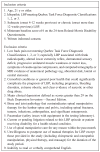Comparison of posteroanterior spinal stiffness measures to clinical and demographic findings at baseline in patients enrolled in a clinical study of spinal manipulation for low back pain
- PMID: 17870417
- PMCID: PMC4283825
- DOI: 10.1016/j.jmpt.2007.07.009
Comparison of posteroanterior spinal stiffness measures to clinical and demographic findings at baseline in patients enrolled in a clinical study of spinal manipulation for low back pain
Abstract
Objective: A system for measuring posterior-to-anterior spinal stiffness (PAS) was developed for use in clinical trials of manipulation for low back pain (LBP). The current report is an analysis of the baseline PAS data, with particular emphasis on relationships between PAS and clinical and demographic characteristics.
Methods: Posterior-to-anterior spinal stiffness measurements were recorded over the spinous processes of the lumbar spines from patients who had LBP. The system uses electronic sensors to record displacement and force, whereas a human operator provides the force of indentation. Clinical and outcome measures were compared with spinal stiffness.
Results: We recruited 192 patients (89 female and 103 male; average age, 40.0 years; SD, 9.4 years). The average Roland-Morris score was 9.7 (SD, 3.2) on a 24-point scale. The Visual Analog Scale pain scores were 55.7 (SD, 20.9) on a 100-mm scale. Stiffness values ranged from 4.16 to 39.68 N/mm (mean, 10.80 N/mm; SD, 3.72 N/mm). Females' lumbar spines were, on the average, 2 N/mm more compliant than males (P < .001).
Conclusions: The PAS system of computer-monitored equipment with human operation performed well in this clinical study of LBP. Spinal stiffness was found to be different between males and females, and age and body mass index were related to PAS. We found no significant relationship between the severity or chronicity of the LBP complaint and spinal stiffness. There was little agreement between the stiff or tender segments identified by the clinicians using palpation and the segment that measured most stiff using the PAS device.
Figures
Similar articles
-
Association of lumbar spine stiffness and flexion-relaxation phenomenon with patient-reported outcomes in adults with chronic low back pain - a single-arm clinical trial investigating the effects of thrust spinal manipulation.BMC Complement Altern Med. 2017 Jun 9;17(1):303. doi: 10.1186/s12906-017-1821-1. BMC Complement Altern Med. 2017. PMID: 28599647 Free PMC article. Clinical Trial.
-
Stiffness and neuromuscular reflex response of the human spine to posteroanterior manipulative thrusts in patients with low back pain.J Manipulative Physiol Ther. 2001 Oct;24(8):489-500. doi: 10.1067/mmt.2001.118209. J Manipulative Physiol Ther. 2001. PMID: 11677547
-
The reliability of a posterior-to-anterior spinal stiffness measuring system in a population of patients with low back pain.J Manipulative Physiol Ther. 2007 Feb;30(2):116-23. doi: 10.1016/j.jmpt.2006.12.006. J Manipulative Physiol Ther. 2007. PMID: 17320732
-
Within- and between-day reliability of spinal stiffness measurements obtained using a computer controlled mechanical indenter in individuals with and without low back pain.Man Ther. 2013 Oct;18(5):395-402. doi: 10.1016/j.math.2013.02.003. Epub 2013 Mar 1. Man Ther. 2013. PMID: 23465962
-
Core Stability Exercise Versus General Exercise for Chronic Low Back Pain.J Athl Train. 2017 Jan;52(1):71-72. doi: 10.4085/1062-6050-51.11.16. Epub 2016 Nov 16. J Athl Train. 2017. PMID: 27849389 Free PMC article. Review.
Cited by
-
Influence of body position and axial load on spinal stiffness in healthy young adults.Eur Spine J. 2020 Mar;29(3):455-461. doi: 10.1007/s00586-019-06254-0. Epub 2019 Dec 18. Eur Spine J. 2020. PMID: 31848714
-
The effect of application site of spinal manipulative therapy (SMT) on spinal stiffness.Spine J. 2015 Jun 1;15(6):1332-8. doi: 10.1016/j.spinee.2013.07.480. Epub 2013 Oct 17. Spine J. 2015. PMID: 24139864 Free PMC article.
-
A randomized clinical trial comparing extensible and inextensible lumbosacral orthoses and standard care alone in the management of lower back pain.Spine (Phila Pa 1976). 2014 Oct 1;39(21):1733-42. doi: 10.1097/BRS.0000000000000521. Spine (Phila Pa 1976). 2014. PMID: 25054648 Free PMC article. Clinical Trial.
-
Association of lumbar spine stiffness and flexion-relaxation phenomenon with patient-reported outcomes in adults with chronic low back pain - a single-arm clinical trial investigating the effects of thrust spinal manipulation.BMC Complement Altern Med. 2017 Jun 9;17(1):303. doi: 10.1186/s12906-017-1821-1. BMC Complement Altern Med. 2017. PMID: 28599647 Free PMC article. Clinical Trial.
-
Preliminary investigation of the mechanisms underlying the effects of manipulation: exploration of a multivariate model including spinal stiffness, multifidus recruitment, and clinical findings.Spine (Phila Pa 1976). 2011 Oct 1;36(21):1772-81. doi: 10.1097/BRS.0b013e318216337d. Spine (Phila Pa 1976). 2011. PMID: 21358568 Free PMC article.
References
-
- Stochkendahl MJ, Christensen HW, Hartvigsen J, et al. Manual examination of the spine: a systematic critical literature review of reproducibility. J Manipulative Physiol Ther. 2006;29:475–85. 485. - PubMed
-
- Seffinger MA, Najm WI, Mishra SI, et al. Reliability of spinal palpation for diagnosis of back and neck pain: a systematic review of the literature. Spine. 2004;29:E413–25. - PubMed
-
- Brodeur RR, DelRe L. Stiffness of the thoracolumbar spine for subjects with and without low back pain. J Neuromusculoskel Syst. 1999;7:127–33.
-
- Kawchuk G, Herzog W. A new technique of tissue stiffness (compliance) assessment: its reliability, accuracy and comparison with an existing method. J Manipulative Physiol Ther. 1996;19:13–8. - PubMed
-
- Kawchuk GN, Fauvel OR, Dmowski J. Ultrasonic indentation: a procedure for the noninvasive quantification of force-displacement properties of the lumbar spine. J Manipulative Physiol Ther. 2001;24:149–56. - PubMed
Publication types
MeSH terms
Grants and funding
LinkOut - more resources
Full Text Sources
Other Literature Sources
Miscellaneous


